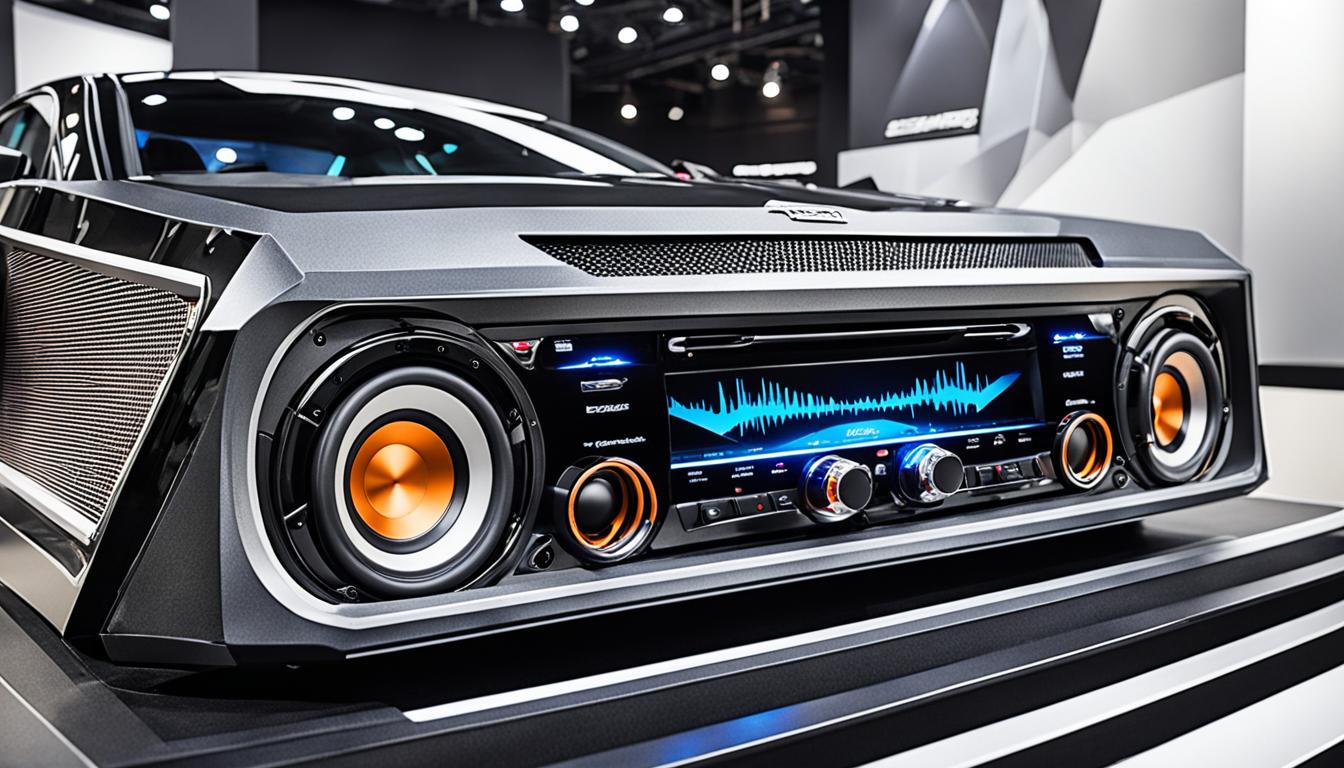As an avid car audio enthusiast, I understand the thrill of constructing a high-performance sound system for competitions and showcases. Upgrading your car audio systems and upgrades is an exciting journey that requires a deep understanding of each component and its importance. Factory-installed car stereo upgrades simply won’t cut it when it comes to delivering the sound quality needed for these events.
To achieve the level of performance required, a component speaker setup that separates the audio frequencies is essential. Pair this with the addition of a powerful subwoofer and amplifier, and you’ll be well on your way to enhancing the system’s overall power and output. An active crossover is also a crucial element, ensuring the proper audio signals are delivered to each speaker for optimal performance.
While this process may seem daunting, seeking expert guidance can make all the difference. Organizations like DBD Drag Racing provide invaluable resources and support to help enthusiasts like myself build competition-ready in-vehicle entertainment systems. With their expertise and the right components, we can transform our vehicles into true audio powerhouses.
Key Takeaways
- Factory-installed speakers won’t deliver the sound quality needed for competitions – a component speaker setup is essential.
- Adding a subwoofer and amplifier can significantly enhance the system’s power and output.
- An active crossover is crucial for delivering the proper audio signals to each speaker.
- Seeking expert guidance, such as from organizations like DBD Drag Racing, can greatly assist in building a competition-ready system.
- Upgrading your car audio systems and upgrades is an exciting journey that requires a deep understanding of each component.
Understanding Car Audio System Components
When it comes to customizing your car audio system for competitions and shows, understanding the key components that make up the system is essential. From the tuner/signal decoder to the amplifier, volume control, equalizer, and speaker setup, each element plays a crucial role in delivering the exceptional sound quality and performance you seek.
Tuner/Signal Decoder
The tuner/signal decoder is the heart of your car audio system, responsible for processing the incoming audio signals from various sources, such as radio, satellite, or digital media. This component takes the raw audio data and converts it into a format that can be amplified and sent to the speakers, ensuring your music or other audio content is delivered with clarity and precision.
Amplifier
The amplifier is the powerhouse of the system, taking the signal from the tuner/signal decoder and boosting it to a level that can effectively drive your speakers. By matching the amplifier’s power output to the speaker’s specifications, you can ensure your car audio system delivers the desired volume and dynamic range, whether you’re competing in sound pressure level (SPL) or sound quality events.
Volume/Potentiometer Control
The volume/potentiometer control allows you to adjust the overall volume of your car audio system, giving you the flexibility to fine-tune the output to your preference or the competition’s requirements. This component works in tandem with the amplifier to ensure you can precisely control the system’s volume without compromising sound quality.
Equalizer
The equalizer is a critical component for fine-tuning the frequency response of your car audio system. By adjusting the levels of different frequency bands, you can tailor the sound to your specific acoustic environment, compensate for any inherent issues in the speakers or vehicle, and optimize the system’s performance for competitions or personal enjoyment.
Speaker Setup: Component vs. Coaxial
The choice between a component speaker setup and a coaxial speaker setup can have a significant impact on the overall sound quality of your car audio system. Component speakers, which separate the tweeters and woofers, offer superior frequency separation and imaging, providing a more immersive and dynamic listening experience compared to the factory-installed coaxial speakers.
| Component Speakers | Coaxial Speakers |
|---|---|
| Separate tweeters and woofers for improved frequency separation and imaging | Tweeters and woofers integrated into a single unit, often with limited frequency separation |
| Provide a more detailed and immersive audio experience | Offer a more basic and compact sound solution |
| Require more installation complexity and tuning | Easier to install and require less system tuning |
| Typically more expensive than coaxial speakers | Generally more affordable than component speakers |
Selecting High-Quality Audio Gear
When outfitting your car audio system for competitions and shows, the selection of high-quality gear is paramount. From speaker sensitivity and power handling to subwoofer RMS power ratings, every component plays a crucial role in delivering the desired sound performance. Equally important is choosing reputable car audio brands that are known for their reliability and exceptional audio quality.
Speaker Sensitivity and Power Handling
One of the key factors to consider when selecting speakers is their sensitivity rating, which indicates how efficiently the speaker converts amplifier power into sound output. Speakers with higher sensitivity ratings tend to require less amplifier power to achieve the same volume level, making them a better match for systems with limited amplifier power. Additionally, pay close attention to the speaker’s power handling capabilities to ensure compatibility with the amplifier’s output.
Subwoofer RMS Power Rating
When it comes to subwoofers, the RMS (Root Mean Square) power rating is a critical specification to look for. The RMS power rating represents the continuous power the subwoofer can handle, which directly correlates to its ability to deliver consistent, high-quality low-frequency output. Opt for subwoofers with a higher RMS power rating to ensure they can handle the demands of competitive car audio environments.
Reputable Brands for Car Audio
To ensure the reliability and performance of your car audio gear, it’s recommended to choose from well-known and respected brands in the industry. Some of the top brands to consider include Alpine, Infinity, JL Audio, and Eclipse. These brands have a proven track record of delivering high-quality speakers, amplifiers, and other audio components that can withstand the rigors of competition-level installations.
Regardless of whether your focus is on sound pressure level or sound quality competitions, selecting the appropriate gear from trusted car audio brands is crucial for achieving your performance goals. By carefully considering speaker sensitivity, power handling, and subwoofer RMS ratings, you can build a car audio system that will impress the judges and captivate the audience.
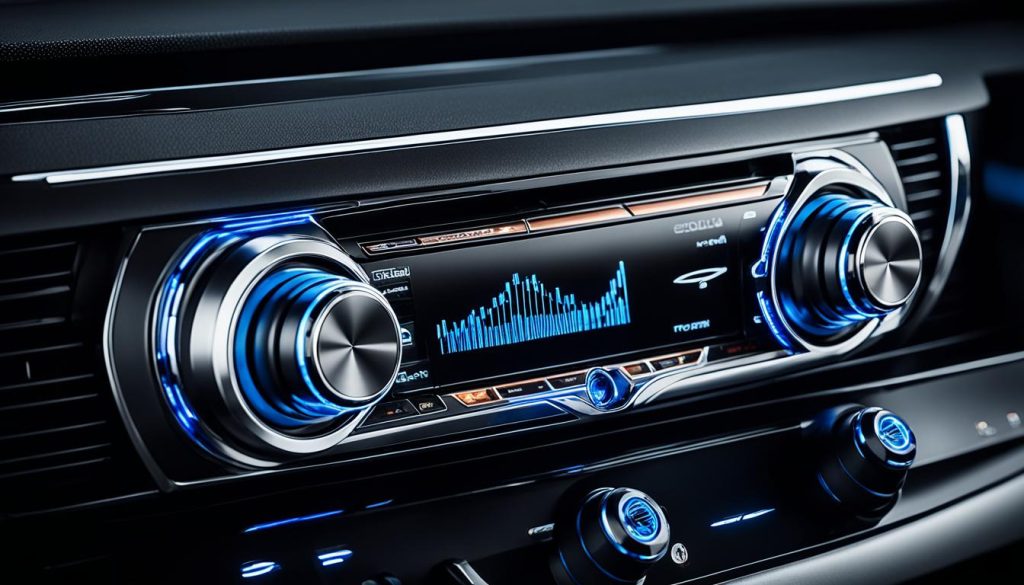
Planning for Your Audio Goals
When it comes to customizing your car audio system, it’s crucial to have a clear understanding of your specific goals. Are you aiming to compete in sound pressure level (SPL) competitions or sound quality competitions? The approach you take will differ significantly depending on your desired outcome.
Sound Pressure Level Competitions
For those seeking to dominate in SPL competitions, the focus will be on obtaining the most powerful, ear-blasting equipment within your budget. This means investing in high-wattage amplifiers, subwoofers with impressive power handling capabilities, and speakers that can handle the sheer volume of the system. The goal in SPL competitions is to achieve the highest decibel levels, creating an audio experience that is nothing short of awe-inspiring.
Sound Quality Competitions
On the other hand, if your goal is to excel in sound quality competitions, the emphasis shifts to finding the highest-rated gear that can deliver exceptional audio fidelity, even if it’s not the loudest system. In this case, you’ll need to prioritize components known for their precise sound reproduction, superior imaging, and overall tonal balance. Researching the competition rules and requirements for each type of event is crucial to ensure your system is properly equipped and tuned to meet the specific judging criteria.
Regardless of whether you’re aiming for SPL or sound quality competitions, the key is to plan your car audio system with a clear understanding of your goals. This will guide your component selection, tuning, and installation, ensuring you create a system that truly stands out in the world of competitive car audio.
Car Audio Systems and Upgrades
Upgrading and customizing a car audio system is a complex but rewarding process. It involves understanding the various components, selecting high-quality gear, and planning for specific competition goals. By starting with a solid understanding of the system’s core elements and then carefully choosing the right speakers, car audio upgrades, amplifiers, subwoofers, and other components, enthusiasts can transform their vehicles into true audio powerhouses for competitions and shows.
The journey of building a competition-ready car audio system requires expertise, attention to detail, and a passion for audio excellence. From selecting the right components to seamlessly integrating them into the vehicle, the end result can be a truly awe-inspiring automotive sound system that’s ready to impress at any event.
| Key Components | Importance for Car Audio Systems |
|---|---|
| Speakers | Delivering high-quality sound reproduction is crucial for both competition and daily driving enjoyment. |
| Amplifiers | Providing the necessary power to drive the speakers and subwoofers for maximum performance. |
| Subwoofers | Enhancing the low-frequency response for a more immersive and impactful audio experience. |
| Crossovers | Ensuring the proper distribution of audio frequencies to the appropriate speaker components. |
By carefully selecting and integrating these key components, car audio enthusiasts can create a system that not only delivers exceptional sound quality but also stands out in competitions and car audio shows.
Amplifier Installation and Integration
Proper amplifier installation and integration is paramount for achieving exceptional audio performance in a car. When choosing an amplifier, it’s crucial to match its power output and specifications to the speakers and subwoofers in your audio system. Carefully considering the car audio wiring requirements is also essential, ensuring the amplifier receives the necessary voltage and current to operate effectively.
Choosing the Right Amplifier
Selecting the appropriate amplifier for your car audio setup involves evaluating factors such as the power handling capabilities of your speakers and subwoofers. You’ll want to choose an amplifier with a power rating that aligns with the recommended RMS (Root Mean Square) power of your audio components. This will ensure optimal performance and prevent potential damage to your speakers or subwoofers.
Wiring and Power Distribution
Once you’ve identified the right amplifier, the next critical step is ensuring proper car audio wiring and power distribution. This includes running the necessary power, ground, and signal cables to the amplifier, as well as ensuring the amplifier is connected to a dedicated and reliable power source. Improper wiring or insufficient power can lead to suboptimal sound quality and, in some cases, even component failure.
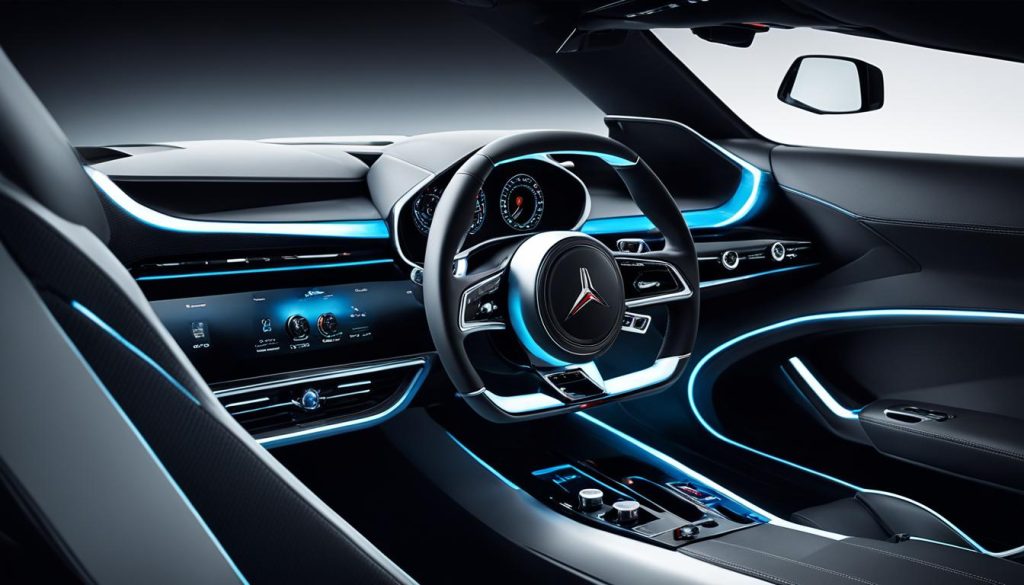
By carefully selecting the appropriate amplifier and meticulously managing the amplifier installation and integration process, you can unlock the full potential of your car audio system, delivering exceptional sound quality and performance.
Subwoofer Enclosure Design and Placement
The design and placement of the subwoofer enclosure can have a significant impact on the overall performance of the car audio system. Whether you choose a ported (bass-reflex) enclosure or a sealed enclosure, each option offers its own unique advantages that can influence the desired sound characteristics and competition goals.
Ported vs. Sealed Enclosures
Ported enclosures, also known as bass-reflex enclosures, utilize a tuned port or vent to enhance the low-frequency output of the subwoofer. This design typically provides a deeper, more powerful bass response, which can be ideal for sound pressure level (SPL) competitions. In contrast, sealed enclosures prioritize control and precision over raw output, offering a tighter and more accurate bass response that may be preferred in sound quality competitions.
The choice between a ported or sealed enclosure ultimately depends on your specific audio goals and the desired sound signature. It’s important to consider factors such as the subwoofer’s specifications, the available space in your vehicle, and the overall tuning of your car audio system to determine the most suitable enclosure type.
Optimal Subwoofer Positioning
Regardless of the subwoofer enclosure design, the positioning of the subwoofer(s) within the vehicle is crucial for maximizing the low-frequency output and integration with the rest of the system. Careful placement can help achieve a seamless transition between the subwoofer and the front speakers, ensuring a cohesive and immersive audio experience.
Common subwoofer placement options include the trunk, the rear seats, or even custom-built enclosures integrated into the vehicle’s interior. The location should be selected based on factors such as available space, desired aesthetics, and the overall acoustic properties of the car’s cabin.
By thoughtfully considering the subwoofer enclosure design and placement, you can optimize the performance of your car audio system and set the stage for success in ported enclosure or sealed enclosure competitions.
Speaker Upgrades and Sound Damping
Upgrading the factory-installed speakers to a high-performance component speaker setup can dramatically enhance the sound quality of your car audio system. Proper installation of the component speakers, including the woofers, tweeters, and crossovers, is crucial for achieving optimal audio performance. This process involves carefully integrating the individual speaker components to ensure seamless frequency separation and exceptional audio reproduction.
Component Speaker Installation
When installing a component speaker system, attention to detail is paramount. Properly mounting the woofers, tweeters, and crossover networks requires strategic placement within the vehicle to create an immersive and cohesive soundstage. Ensuring the correct wiring connections and crossover settings is essential for unlocking the full potential of your speaker upgrades.
Sound Damping Materials
In addition to upgrading the speakers, incorporating sound damping materials into your car’s interior can significantly improve the overall audio experience. The use of dense foam or mass-loaded vinyl, strategically applied to panels and surfaces, can help reduce unwanted vibrations and resonances. This sound damping process helps to minimize audio distortions and enhance the clarity and fidelity of your component speaker installation.
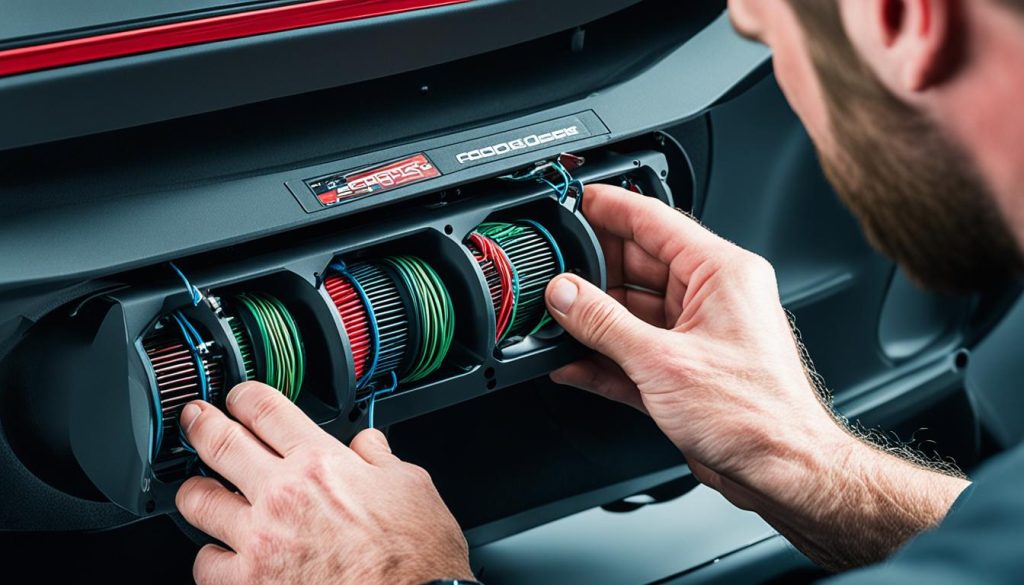
Head Unit and Source Unit Upgrades
Upgrading the head unit or source unit can have a significant impact on the overall sound quality and functionality of your car audio system. Replacing the factory-installed head unit with a high-performance aftermarket unit can provide you with access to advanced features, improved sound processing, and better integration with modern audio sources, such as smartphones, tablets, and streaming services.
One of the key benefits of upgrading your car audio source is the ability to take advantage of the latest technologies and features. Many aftermarket head units offer built-in support for popular music streaming platforms, seamless smartphone integration, and even advanced sound-shaping tools like digital signal processing (DSP) and parametric equalization. These features can help you fine-tune your system’s sound signature and create a more immersive listening experience.
Moreover, replacing your factory head unit can also improve the overall sound quality of your car audio system. Aftermarket units often feature higher-quality digital-to-analog converters (DACs) and signal processing, which can result in a cleaner, more detailed audio output. This can be especially beneficial if you’ve already invested in high-quality speakers, amplifiers, and other components in your system.
| Feature | Factory Head Unit | Aftermarket Head Unit |
|---|---|---|
| Audio Source Support | Limited to factory-installed options | Supports a wide range of modern audio sources, including smartphone integration, Bluetooth, and streaming services |
| Sound Processing | Basic equalization and sound shaping | Advanced digital signal processing (DSP), parametric equalization, and other sound-tuning tools |
| Display and User Interface | Basic, often outdated display and controls | Larger, high-resolution displays with intuitive touch-based controls and customizable interfaces |
| Overall Sound Quality | Limited by factory-installed components | Improved sound quality through higher-quality DACs and signal processing |
When it comes to head unit upgrades and source unit upgrades for your car audio system, the key is to choose a solution that not only enhances the sound quality but also integrates seamlessly with your vehicle and meets your specific needs and preferences. By investing in a high-performance aftermarket head unit, you can take your in-vehicle entertainment to the next level and enjoy a truly immersive and personalized listening experience.
Vehicle-Specific Audio Solutions
Achieving the optimal car audio solution often requires a tailored approach to accommodate the unique characteristics and constraints of the vehicle. This entails leveraging custom fabrication and installation techniques to seamlessly integrate the audio components with the vehicle’s unique design and layout.
Custom Fabrication and Installation
From custom-built enclosures to specialized mounting solutions, the process of vehicle-specific audio integration demands a keen eye for detail and a deep understanding of both the audio system and the vehicle itself. By carefully crafting custom elements, the installation can be optimized for maximum performance and aesthetics, ensuring the audio components complement the vehicle’s overall design.
Vehicle Integration and Aesthetics
The ultimate goal of audio integration is to create a visually appealing and cohesive installation that enhances the vehicle’s existing car audio aesthetics. This might involve seamlessly integrating speakers, subwoofers, and other audio components into the vehicle’s interior and exterior, achieving a harmonious blend of form and function.
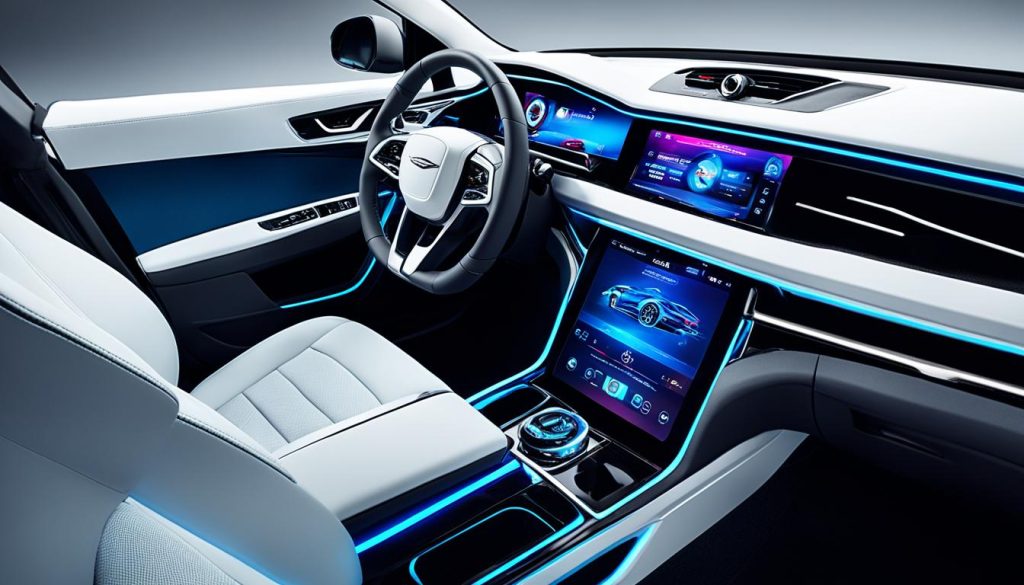
By leveraging custom audio fabrication and meticulous audio integration techniques, enthusiasts can transform their vehicles into true audio showcases that deliver exceptional performance while maintaining a visually stunning, factory-like appearance.
Competition Preparation and Strategies
Preparing a car audio system for competition requires a meticulous approach to ensure it performs at its absolute best. Whether your goal is to excel in sound quality or sound pressure level (SPL) competitions, the key lies in strategic tuning and optimization.
Sound Quality Tuning and Optimization
For sound quality competitions, the focus shifts to fine-tuning the system’s frequency response, soundstage, and imaging. This involves making precise adjustments to the equalizer, crossovers, and other signal processing parameters to achieve a balanced, immersive, and accurate audio experience. By meticulously calibrating these elements, you can create a captivating soundscape that will impress the judges and audiophiles alike.
Sound Pressure Level Maximization
In contrast, for sound pressure level competitions, the goal is to maximize the overall output and volume of the system. This often requires strategic placement and tuning of the subwoofers and amplifiers to unleash the full potential of the low-frequency performance. By optimizing the enclosure design, power distribution, and speaker integration, you can push the boundaries of what’s possible in terms of sheer audio output and presence.
Regardless of your competition focus, preparation is key. Seek guidance from experienced competitors, attend workshops, and experiment with different techniques to fine-tune your system for the ultimate performance on the competition stage.
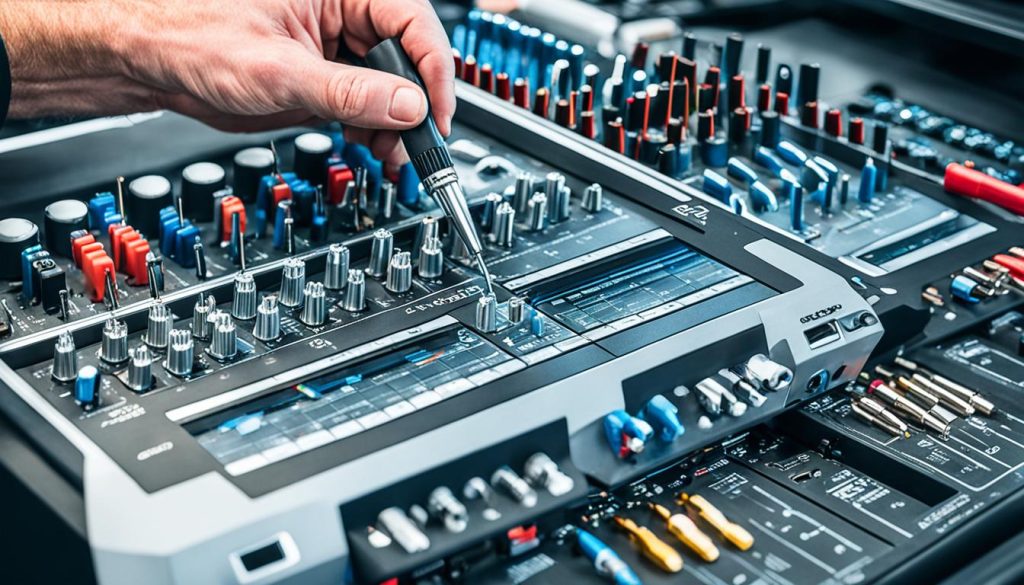
Conclusion
As I reflect on the journey of customizing my car audio system for competitions and shows, I’m filled with a sense of pride and accomplishment. The process of understanding the key components, selecting high-quality gear, and carefully integrating the system into my vehicle has been both challenging and rewarding. By focusing on my specific audio goals, whether it’s achieving the highest sound pressure level or delivering exceptional sound quality, I’ve been able to transform my car into an impressive audio showcase.
The path to building a competition-ready car audio system requires a deep understanding of the equipment, meticulous attention to detail, and a genuine passion for audio excellence. Each step, from upgrading the speakers and amplifiers to optimizing the sound through tuning and adjustments, has been a testament to my dedication and commitment to this craft. The end result is a truly awe-inspiring automotive sound system that not only performs exceptionally well but also complements the overall aesthetics of my vehicle.
As I prepare to compete in upcoming car audio competitions and shows, I’m excited to see how my customized system will perform. The journey of car audio system customization has been a truly rewarding experience, and I’m grateful for the knowledge and skills I’ve gained along the way. Whether you’re aiming for sound pressure level or sound quality competitions, the key is to embrace the process, learn from experts, and unleash your passion for audio perfection.
FAQ
What are the key components of a car audio system?
What is the difference between component and coaxial speakers?
What should I look for when selecting car audio gear?
What are the key differences between sound pressure level (SPL) and sound quality competitions?
Why is proper amplifier installation and integration crucial?
How does the subwoofer enclosure design and placement impact the system’s performance?
What are the benefits of upgrading to a component speaker setup?
How can upgrading the head unit or source unit improve the system’s performance?
What are the key considerations for achieving a custom, competition-ready car audio installation?
How do you prepare a car audio system for competition?
Source Links
- https://www.highdowncaraudio.com/competition-cars.html
- https://auto.howstuffworks.com/under-the-hood/aftermarket-accessories-customization/car-audio-competition.htm
- https://www.instructables.com/How-to-Make-Your-Own-Car-Stereo/
